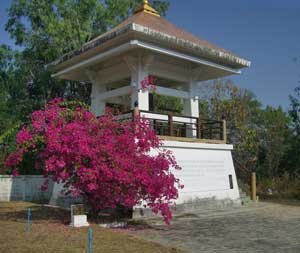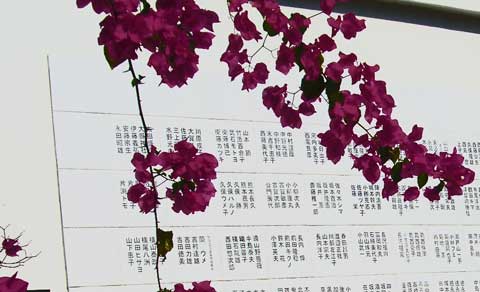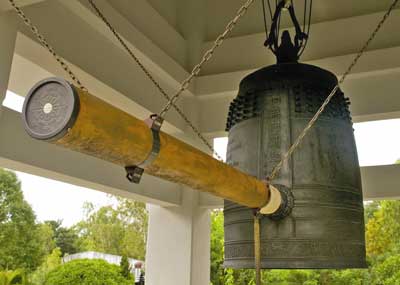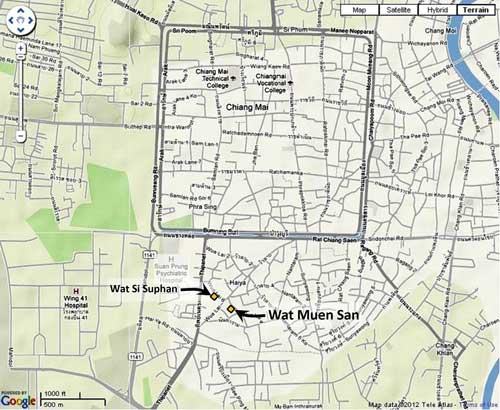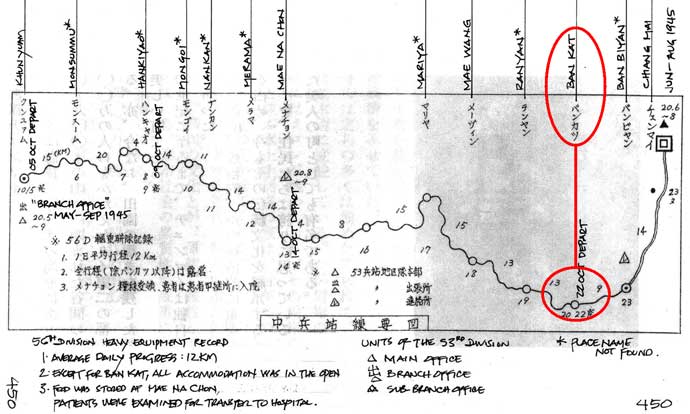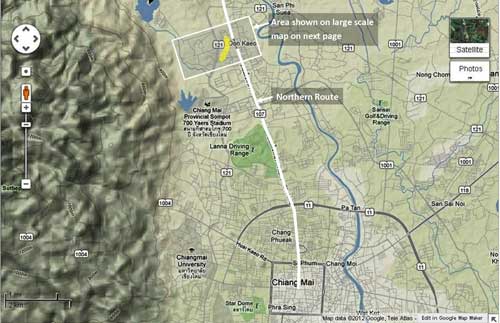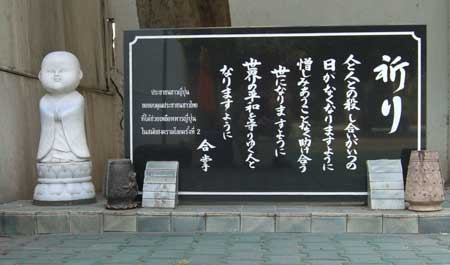The Bell Tower at Ban Kat
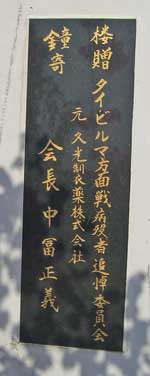
Plaque to left of donors’ list:3
Design and construction of the bell tower by Commission of Japanese War Veterans from the Thai-Burma Campaign.
Masayoshi Nakatomi
Chairman (retired)
Husamitsu Medicine Co
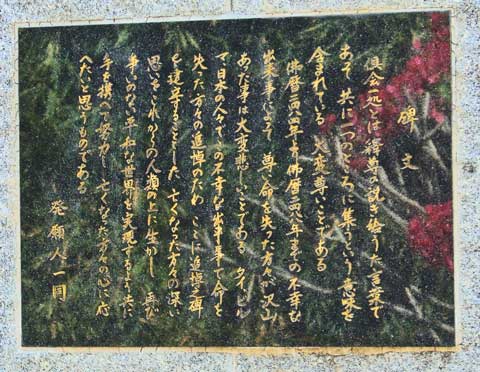
On one side of the bell tower is this inscription:4
A message from those who constructed the bell tower:
Let us assemble here to show our respect for the teachings of Buddha. During the period, 1941-1945, many people died because of an unnecessary war. This is very sad. As war veterans who served in Burma and Thailand, we decided to build this monument. In doing this, we hope to make the best use of their experience: we will make an effort to realize a peaceful world. We hope to meet these expectations.
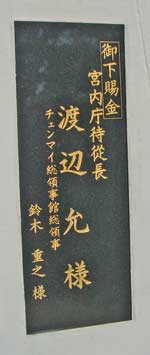
Plaque to right of donors’ list:5
Donation through auspices of
Head of
Imperial Household Agency
Mr Watanabe
Japanese Consul, Chiang Mai
Mr Shigenori Suzuki
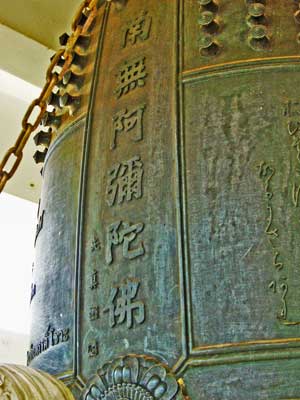
A name for Buddha used in addressing him in prayer7
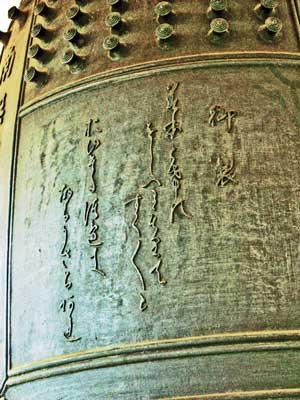
A poem by the Showa Emperor (Hirohito)8
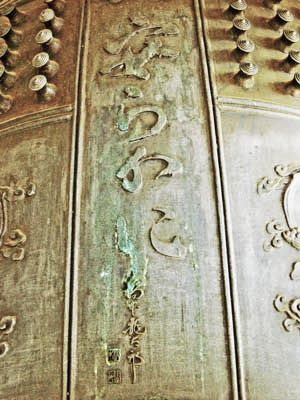
Rest in peace
Ryutaro Hashimoto, Prime Minister 1996-19989
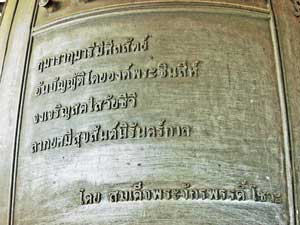
Thai translation of the Emperor’s poem:10
Following in the way of Buddha, people can
enjoy life-long prosperity and happiness.
The Showa Emperor (Hirohito)
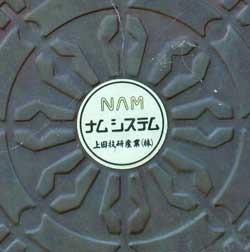
Manufacturer of wooden striker:11
Namu Shisutemu
Ueda Giken Sanguio, Ltd

Bell manufacturer:12
Tetsuhiro Iwazawa
Kyoto Prefecture
Inscriptions on the War Memorial in Ban Kat
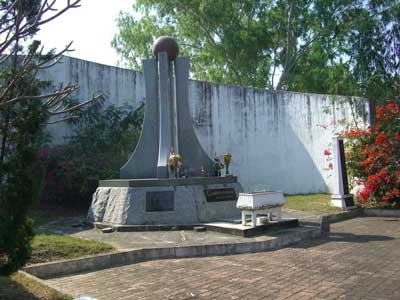
Memorial, built directly over an old water well
which serves as a repository for remains of IJA soldiers13
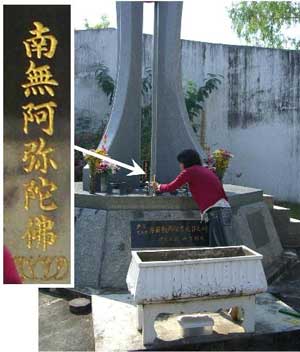
The stele at the center of the monument
displays a name used for addressing Buddha in prayer14
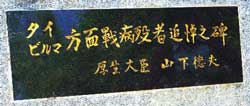
Inscription at front of memorial base:15
Monument to Japanese military personnel who perished in Thailand and Burma.
Norio Yamashita Minister of Welfare
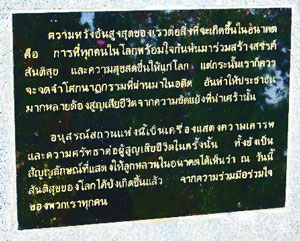
Thai inscription, left of center on memorial base:16
Our aim is that everyone unite in the creation of peace and happiness. The tragic conflict that cost so many lives must never be forgotten. This building is a symbol of respect for, and faith in, those who gave their lives.
It is intended as a reminder for future generations that world peace requires the cooperation of all.
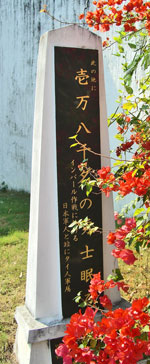
Column to right of memorial:17
Here, 18,000 brave soldiers sleep.
[Erected] by Japanese and Thai Army personnel concerned about the battle at Imphal (a separate plinth duplicates the information in Thai)
Comment:
Note that the monument addresses generally two groups of deceased: “Japanese military personnel who perished in Thailand and Burma” and “Japanese and Thai Army personnel concerned about the battle at Imphal”. The former were estimated at 190,899 (Journal, p 560), covering all years of action in Burma. For the latter, citing “The Battle at Imphal” was probably intended to include all lost during the U-Go Offensive, March through June 1944, which involved not only Imphal, but also Kohima, with 30,502 deaths. Estimates for IJA deaths only at Imphal are not so well defined, combining killed and wounded at 54,879.18
The number 18,000 seen at the monument appears in many places in Etou Foundation literature in reference to the total number of remains discovered and reinterred at the memorial. While not impossible, the number is unlikely. In 1977-1978, IJA veterans with government support in a very methodical, well organized effort were able to retrieve a total of 1,867 remains from Thailand.19
Prevailing in most of the areas searched is a wet, tropical climate which is highly destructive to bone. Fifteen years after (1992 and later), a second, less sophisticated effort was made; bones had been in the ground for a total of, say, 45 years; memories had grown dimmer. While searchers at this later date claim to have found almost ten times as many additional remains, the 18,000 seems unrealistic.
That said, the monument should be viewed as recognizing all the IJA personnel who died in Thailand, Burma, and India, tallied at 190,899.20
All Axis forces deaths should be considered honored at this memorial.
- Author photo: cimg2235.jpg, 07 Jan 2008[↩]
- Author photo: cimg2250a.jpg, 07 Jan 2008[↩]
- Author photo: cimg2248a.jpg, 07 Jan 2008[↩]
- Author photo: cimg2239a.jpg, 07 Jan 2008[↩]
- Author photo: cimg2249a.jpg, 07 Jan 2008[↩]
- thaigerpics-uap-46.tif, 27 Jul 2008. Courtesy of ‘Gus’ Gutteridge, Thaigerpics[↩]
- Author photo: CIMG2253a.jpg, 07 Jan 2008[↩]
- Author photo: CIMG2256a.jpg, 07 Jan 2008[↩]
- Author photo: CIMG2255a.jpg, 07 Jan 2008[↩]
- Author photo: CIMG2254a.jpg, 07 Jan 2008[↩]
- Author photo: CIMG2258a.jpg, 07 Jan 2008[↩]
- Author photo: CIMG2259a.jpg, 07 Jan 2008[↩]
- Author photo, CIMG2246a.jpg, 07 Jan 2008[↩]
- Composite of CIMG2243 & CIMG2245.jpg author photos, 07 Jan 2008[↩]
- Author photo: CIMG2238.jpg, 07 Jan 2008[↩]
- Author photo: CIMG2237a.jpg, 07 Jan 2008[↩]
- Author photo: CIMG2241a.jpg, 07 Jan 2008[↩]
- Wikipedia: “Battle of Imphal” (external link) [↩]
- In their three country effort (Burma, India, Thailand), searchers found 35,019 remains of an estimated 190,899 dead (Journal, p 560). The vast majority of casualties and retrievals were in Burma (ibid).[↩]
- Chidorigafuchi National Cemetery, (external link) 千鳥ケ淵戦没者墓苑, (per Wikipedia: Burma Campaign, Note 23) (external link), a national Japanese cemetery and memorial for unidentified war dead of the Second World War, located near the inner moat of the Imperial Palace and Yasukuni Shrine in Tokyo, tallies 164,500 unidentified remains from just the Burma campaign. To that number should be added those remains not retrieved which can only be estimated as well as those retrieved and identified. Allen calculated 185,149 Japanese died in Burma (Louis Allen, Burma the Longest War (London: Phoenix, 1984), 640). Wikipedia estimates IJA “Casualties and Losses” at about 200,000 (ibid, “Casualties and Losses”). Useful observations about WWII IJA casualties in Southeast Asia are offered on-line in The Battlefield Experience of Japanese Soldiers in the Asia-Pacific War (external link) by Yoshida Yutaka.[↩]
